Articles
Rise of the Eco-Comics:
The State, Environmental Education and Canadian Comic Books, 1971-1975
Abstract
In the 1960s and 1970s, North American governments used comic books with explicitly modern environmental themes or, as I have termed them, “eco-comics” as part of state-sponsored environmental education programs designed to mitigate the possible effects of the bourgeoning environmental movement on economic growth. This article contextualizes the eco-comic Captain Enviro (1972) within the post–Second World War anglophone Canadian comic book industry, discusses the emergence of environmental education in the 1960s and 1970s and uses a visual cultural analysis of Captain Enviro to unravel some of the nuances of the type of environmentalism advocated by the state—in this particular case, the Committee of Environment Ministers of the Council of Maritime Premiers—during this period.
Résumé
Dans les années 1960 et 1970, les gouvernements nord-américains ont utilisé des bandes dessinées aux thèmes explicitement environnementalistes, ou, comme je les ai appelés, des eco-comics (« éco-BD ») en tant que parties intégrantes de programmes de sensibilisation à l’environnement afin d’atténuer les effets possibles de l’émergence du mouvement environnementaliste sur la croissance économique. Cet article replace dans son contexte « l’éco-BD » Captain Enviro (1972) au sein de l’industrie canadienne de la bande dessinée dans les années suivant la Seconde Guerre mondiale, discute de la naissance de l’éducation à l’environnement dans les années 1960 et 1970 et procède à l’analyse visuelle de Captain Enviro sur le plan culturel pour dévoiler certaines des nuances du type de sensibilisation à l’environnement prônée par l’État—dans ce cas particulier, le Comité des ministres de l’Environnement du Conseil des ministres des Provinces maritimes—au cours de cette période.
1 “Captain Enviro says: ‘There is still time to save the Maritime environment!’” These are the words emblazoned across the back cover of a short comic book produced by the company Comic Book World in 1972. Captain Enviro chronicles the adventures of an environmental superhero as he “fight[s] to save the Maritimes” in eastern Canada from alien beings called the Pollutians (Captain Enviro 1972).1 Notwithstanding its somewhat corny appearance and plot, Captain Enviro was a physical manifestation of a larger transition in North America in how the state responded to growing concerns about the environment in the 1960s and 1970s. Governments used comic books with explicitly modern environmental themes or, as I have termed them, “eco-comics” as part of state-sponsored environmental education programs designed to mitigate the possible effects of the bourgeoning environmental movement on economic growth. The eco-comic Captain Enviro was published by the Committee of Environment Ministers, a sub-committee of the Council of Maritime Premiers. The committee used the comic book to advocate a more conservative form of environmentalism, one that was focused on individual actions, rather than society-wide solutions, to Maritime youth. Fundamentally, Captain Enviro serves as an excellent example of the literature produced by state-sponsored environmental education programs in the 1960s and 1970s, and an analysis of its content provides a deeper understanding of the appropriation of environmental education by North American governments during this period.
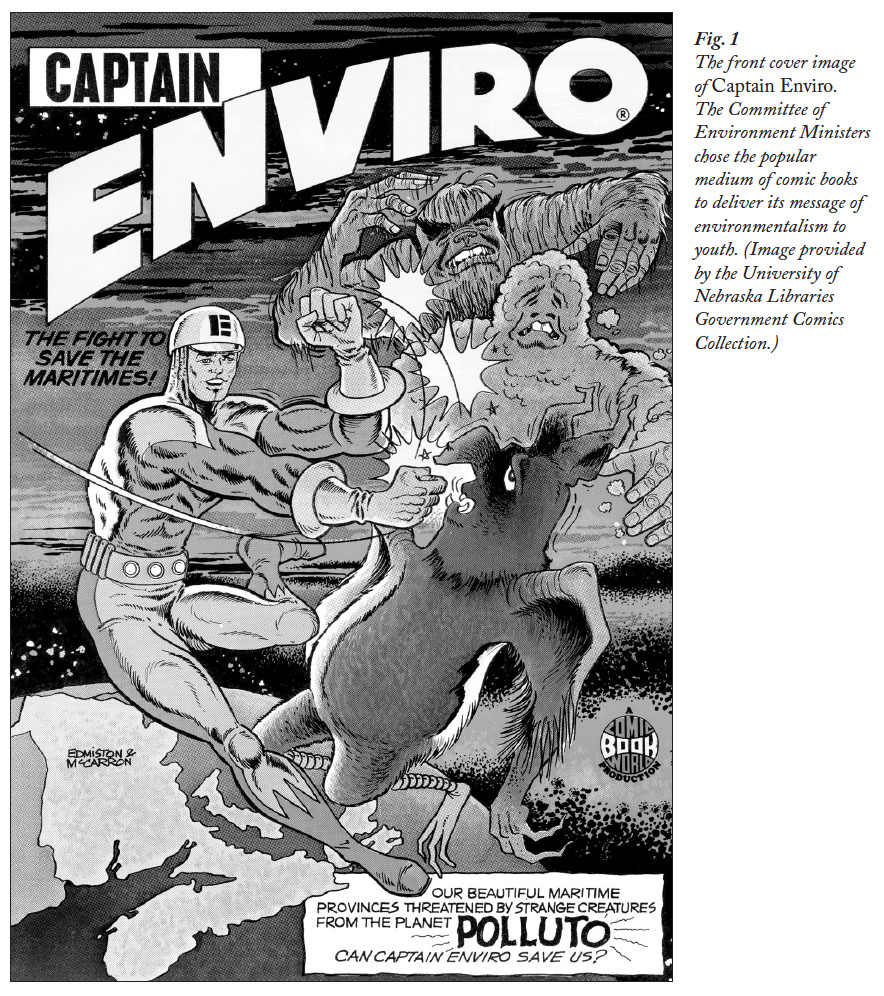 Display large image of Figure 1
Display large image of Figure 1The Comic Book Medium
2 The medium of comics has been around for many decades and comes in a variety of forms, from different cultural backgrounds, and so it is rich in material for academic study. Comics have been produced since at least the 1830s and 1840s, when the Swiss author, painter and teacher Rodolphe Töpffer published his illustrated books of satire (Kunzle 2007). Despite this longevity, scholars and much of the general public maligned comics for many years as frivolous and juvenile, but some started to devote serious academic attention to the medium in the second half of the 20th century. By the 1980s and 1990s, what has been referred to as the “new comics scholarship,” or comics studies, had begun to emerge. Jeet Heer and Kent Worcester have described the sorts of historical and theoretical questions now addressed within this growing field:
The scholar Richard L. Graham has examined how, starting in the 1940s, governments in the United States used comics, particularly comic books, as educational tools and to shape public opinion. He notes that the state “had certain ideals in mind with regard to what American culture was and ought to be, and it recognized the mass appeal of comics and their potential for getting those cultural messages across” (Graham 2011: 13).
3 The founding of the anglophone Canadian comic book industry occurred during the Second World War.2 Comic books in their modern form first appeared in the 1930s as small magazines of “funnies” and adventure strips aggregated from newspapers. The medium gained widespread popularity in North America after the publication of Action Comics No. 1, which featured the initial appearance of Superman, in June 1938. Children quickly embraced this inexpensive form of entertainment, but those in Canada were soon cut off from the 100 per cent American-dominated comic book industry when in December 1940 the Canadian government introduced the War Exchange Conservation Act, banning such non-essential imports as comic books from the U.S. as part of efforts to prepare the country for war. Lasting until 1945, several mainly Toronto-based companies, such as Maple Leaf Publishing and Anglo-American Publishing, took advantage of the ban and published a range of original comics material. Comic book historian John Bell has called the period from 1941 to 1946 the “Golden Age” of Canadian comic books.3 One of the most popular themes of the Golden Age comics was the national superhero: patriotic do-gooders who battled Nazis with superhuman abilities. Captain America was the archetypal national superhero in the U.S., while the first distinctly Canadian national superhero was Nelvana of the Northern Lights (June 1941), who also happened to be one of the first female superheroes (Bell 1986: 19-28; 2006: 33-56). The primary messages of the national superhero comics of the early 1940s were patriotic and propaganda-driven. As Christopher Murray has pointed out, in reference to the role that comics had as propaganda in the U.S. during the Second World War:
In other words, national superheroes like Nelvana of the Northern Lights were used to convey a sense of moral rightness in opposition to what was effectively portrayed as Nazi supervillainy.4
4 The post-war years were tumultuous for the Canadian comic book industry. Many of the Canadian comic book publishers did not survive the end of the federal ban on non-essential imports in 1945, while the others recast themselves as “reprint” firms, or companies reprinting American titles in Canada. From late 1947 to 1951, the Canadian government reinstated the import ban to protect U.S. exchange reserves, although the new regulations still allowed Canadian companies to reprint American titles. Most of the more than ten publishers that participated in this branch plantstyle reprinting business went bankrupt once comic books printed in the U.S. again flooded the Canadian market after 1951 (Bell 1986: 28-31; 2006: 89-92). The few remaining publishers also had to deal with an anti–comic book fervour that swept North America in the late 1940s and 1950s because of a significant change in the content of the comic books. National superhero comics had lost much of their appeal after the end of the Second World War, and so North American publishers switched to producing mystery, crime and horror comics to maintain readerships in the post-war period. In quick succession, parent–teacher associations, community groups and church organizations criticized what they perceived as the negative effects of such content on children, supposedly responsible for everything from juvenile illiteracy to sexual deviancy. Following an incident in British Columbia in 1948, when two adolescent comic book readers accidentally shot and killed a man, Canada’s anti-comics crusaders successfully lobbied for the passage of federal legislation that put restrictions on so-called immoral content in 1949.5 The anti–comic book campaign continued throughout the 1950s, spurred on by the circulation of several anti-comics publications, the most notorious of which was psychiatrist Frederic Wertham’s Seduction of the Innocent, a book-length study that argued that the content of comic books was harmful to children. Finally, amid a range of pressures, including convictions under the immoral content law, the last of the Canadian reprint companies, Superior Publishers, folded in 1956 (Wertham 1954; Brannigan 1986; Bell 2006: 92-100).6
5 Until the beginning of the “Silver Age” of Canadian comic books, heralded in part by the publication of Captain Canuck No. 1 in July 1975, the comic book art tradition survived in Canada in two basic forms. The first was the underground comix movement, which flourished in Canada from approximately 1967 to 1974. Partly a response to the anti-comics campaign, comix were small press or self-published comic books that contained satirical, countercultural and frequently explicit material. The second form was educational giveaways, which were free promotional comics commissioned by governments or corporations and often distributed through schools. Two main companies produced giveaways in Canada in the 1960s and 1970s: Ganes Productions in Toronto, Ontario, and Comic Book World in Halifax, Nova Scotia (Bell 1986: 35-39; 2006: 100-102).
6 Comic Book World was the brainchild of Owen McCarron. Originally founded as Comic Page Features in 1965, McCarron changed the company’s name in 1969. Comic Book World was a combination of McCarron’s love for comics, his abilities as a comics artist and the skills he developed as part of his regular job as an advertising director with the Halifax Chronicle Herald. McCarron, with the help of his creative collaborator Robin Edmiston, produced close to thirty original educational giveaways from 1965 to 1981. Comic Book World, for example, designed four comics for the federal Department of Consumer and Corporate Affairs, featuring the Martian characters Binkly and Doinkel, who warned children about the dangers of household poisons (Bell 1986: 52, 54; 2006: 100-102). Similarly, the governments of the Maritime provinces sought out the services of Comic Book World as part of an environmental education program in the early 1970s, an action that gave birth to Captain Enviro.
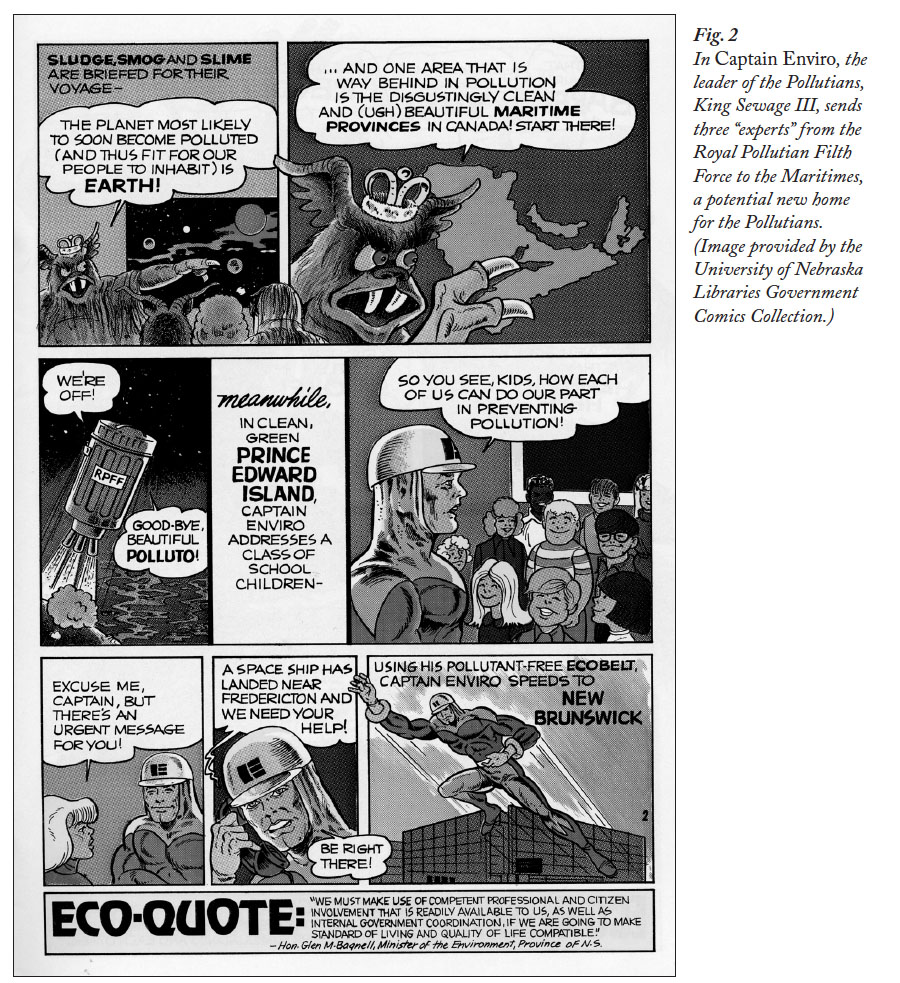 Display large image of Figure 2
Display large image of Figure 2The State and Environmental Education
7 State-sponsored environmental education was part of a general shift in government response across North America to the rise of modern environmentalism. Modern environmentalism developed in the years after the Second World War due to the confluence of a number of factors, including the ideological precedents of conservation and preservation, a series of environmental issues at the local, national and global levels, and the gradual emergence of ecology as a distinct scientific discipline. By the 1960s, North Americans had begun to form groups, and in turn a larger movement, to advocate for more effective environmental regulations and for an end to what many considered to be unconstrained post-war economic growth (Barr 1995; Read 1996; Keeling 2004; Zelko 2004; O’Connor 2010; McLaughlin 2011). Government officials, meanwhile, were worried about how the bourgeoning environmental movement might affect economic activity, and so they implemented a number of measures to mitigate potential resistance. Essentially, the state used such measures as the creation of environmental divisions and departments within government bureaucracies in the 1960s and 1970s to legitimate its presumed function as the manager or steward of natural resources and ecosystems within its territorial borders, with the intention of appeasing enough environmental concerns so as to maintain largely uninterrupted economic growth. State mitigation of resistance was particularly prevalent in incidents of organized development of nature through state-sponsored megaprojects, a trend well documented by scholars who have examined the application of modernization theory in Canada in the mid-20th century (M. Wright 2001; Loo 2004; Kenny and Secord 2010; McLaughlin 2013).
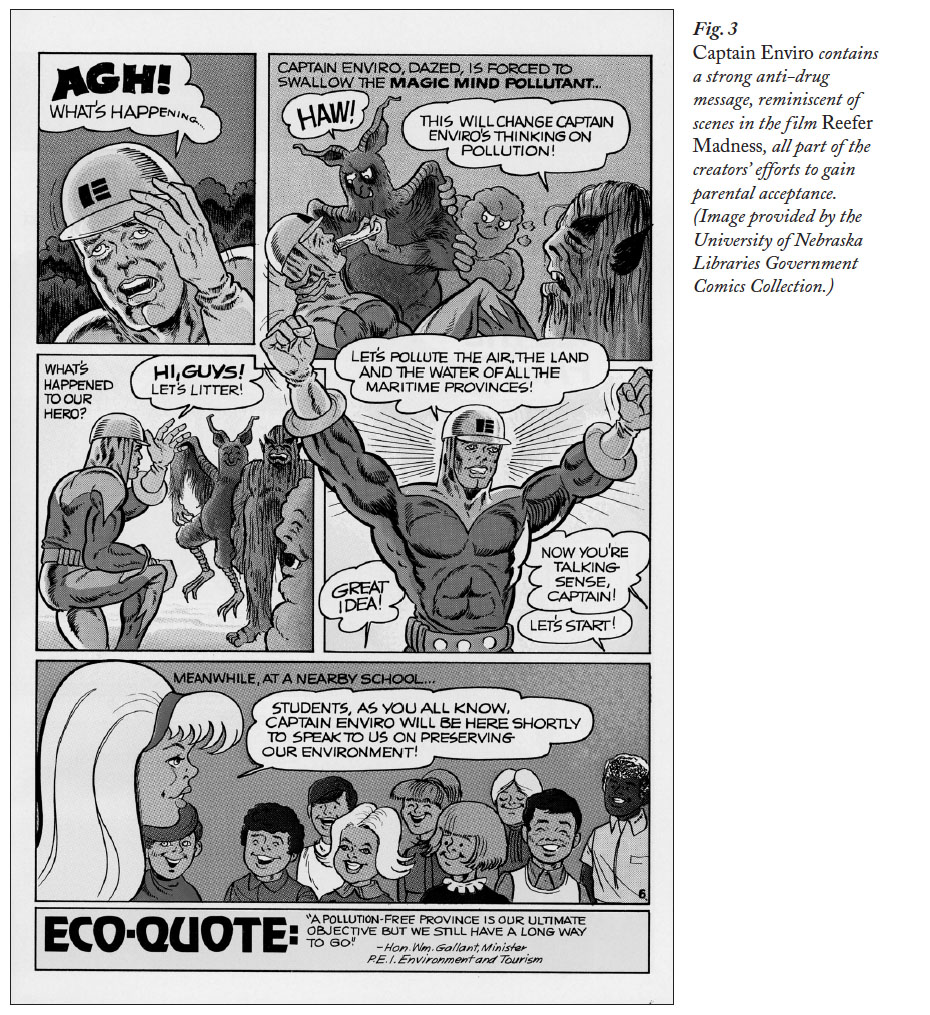 Display large image of Figure 3
Display large image of Figure 38 Another one of the mitigation measures implemented by governments was environmental education programs. The roots of environmental education extend back to recreational camping and nature study programs in the late 19th and early 20th centuries, but emerged as a formal educational approach in the 1960s. This was due in large part to the work of William B. Stapp, a professor in the Department of Resource Planning and Conservation at the University of Michigan and regarded by many as the founder of the modern environmental education movement. In 1969, Stapp, along with a colleague and seven graduate students, published the first comprehensive definition of environmental education. Stapp maintained that environmental education programs should be “aimed at producing a citizenry that is knowledgeable concerning the biophysical environment and its associated problems, aware of how to help solve these problems, and motivated to work toward their solution” (Stapp et al. 1969: 31; Krodel 2003). In the 1970s, the influence of environmental education spread quickly. President Richard Nixon signed into law the Environmental Education Act, which established an Office of Environmental Education within the U.S. Department of Health, Education and Welfare in October 1970. Moreover, major international conferences were held in Stockholm, Sweden, in 1972; Belgrade, Yugoslavia, in 1975; and Tbilisi, Georgia, in 1977. Environmental education was even adopted as an initiative by the United Nations Educational, Scientific and Cultural Organization (UNESCO) by the late 1970s (Chase 1985; Carter and Simmons 2010). However, environmental education programs were frequently more than noble-minded policies and projects. The state, in pursuit of its own political and economic objectives, used such programs to foster within citizenries particular types of environmental knowledge, awareness and motivations that were deemed not to inherently threaten economic growth, such as the act of recycling, much of which occurred post-consumer. This is not to suggest that all state-sponsored environmental education followed this exact pattern of appropriation, but it was commonplace throughout North America in the 1960s and 1970s.
9 The Maritime governments’ environmental education strategy emerged through discussions about regional cooperation in 1971.7 A formal union of New Brunswick, Nova Scotia and Prince Edward Island was an idea that predated the Confederation of Canada in 1867, and Maritime Union resurfaced among the local political class in the 1960s as a possible solution for the region’s so-called have-not economic status. The Deutsch commission, collectively appointed by the Maritime premiers, recommended full union in 1970, but the Maritime governments “decided in favour of establishing formal means of promoting their unity of purpose, of improving communications among their provinces and of establishing the framework for joint undertaking by the three provinces” (Council of Maritime Premiers 1973: 3; Stanley 1993: 424-25). The umbrella organization established to facilitate greater regional cooperation was the Council of Maritime Premiers, and one of the first sub-committees created under the council was the Committee of Environment Ministers. After planning meetings in Charlottetown in April 1971, the committee forwarded to the council a communiqué that addressed “possibilities of co-ordination and integration of effort in the field of environmental affairs.” One of four proposals in the communiqué was “co-operation in matters of public education and public relations ... [through] ... common pamphlets, brochures, films and other types of educational material” (Hatfield to Cockburn, June 4, 1971). The Council of Maritime Premiers subsequently agreed to all four of the committee’s proposals at its next meeting in Fredericton in late May 1971 (Meeting minutes of the Council of Maritime Premiers, May 25-26, 1971).
 Display large image of Figure 4
Display large image of Figure 410 The Committee of Environment Ministers adopted a wide and varied approach for the environmental education program of the early 1970s. In 1973, for example, the first year of the program, the total budget was $90,000, and thousands of Maritimers were reached through television and radio public service announcements, newspaper advertisements and messages printed on garbage bags meant to be used in cars. By the mid-1970s, government officials were even discussing the possibility of purchasing twenty-six one-minute spots during the regional broadcast of Hockey Night in Canada, a popular weekly Canadian Broadcasting Corporation television program that features National Hockey League games (Toole to Hatfield, June 1, 1973; Meeting minutes of the Committee of Environment Ministers, June 7-8, 1974 and July 10-11, 1975; Council of Maritime Premiers 1974: 17-18).8 The main focus of the campaign, though, was outreach to youth through public schools. According to officials, elementary school teachers could adapt lessons from adult publications and high school students could rely on “popular technical journals,” so the production of new educational materials should be aimed at the junior high level (New Brunswick Department of Fisheries and Environment 1973). Teaching kits were designed for use in “classrooms ... during a two-week period for provision of eight lesson periods of 45 minutes each,” and consisted of “environmental notes” for the teacher, classroom posters, information booklets and copies of a comic book titled Captain Enviro (Meeting minutes of the Committee of Environment Ministers, May 6, 1974; Council of Maritime Premiers 1974: 17-18).
11 The Committee of Environment Ministers used the educational program to advocate a particular sort of environmental message. The April 1971 communiqué to the Council of Maritime Premiers stated, “It is important that the public be educated to the true facts of the pollution problem as opposed to the scare propaganda which is so common today” (Hatfield to Cockburn, June 4, 1971). Similar language appeared in the minutes of the July 1975 meeting of the Committee of Environment Ministers.When discussing the teaching kits handed out as part of the educational program, one official described “the way in which they may be used in classrooms to give students a better understanding of the environment and the need for conservation and preservation without use of ‘the scare technique’” (Meeting minutes of the Committee of Environment Ministers, July 10-11, 1975). The use of such language indicates the desire of government officials to mitigate resistance by means of an educational campaign highlighting “the true facts,” as framed by the state, about environmental problems and solutions. The committee was thus advocating a more conservative form of modern environmental values to counter what they would have considered to be the radical and even subversive values of much of the nascent North American environmental movement. The Maritimes were highly reliant on a few dominant resource-based industries—forestry, fishing, agriculture and mining—and so government officials wanted to spread a pro-environment message without harbouring ill will toward the industries that formed the backbone of the region’s economies.
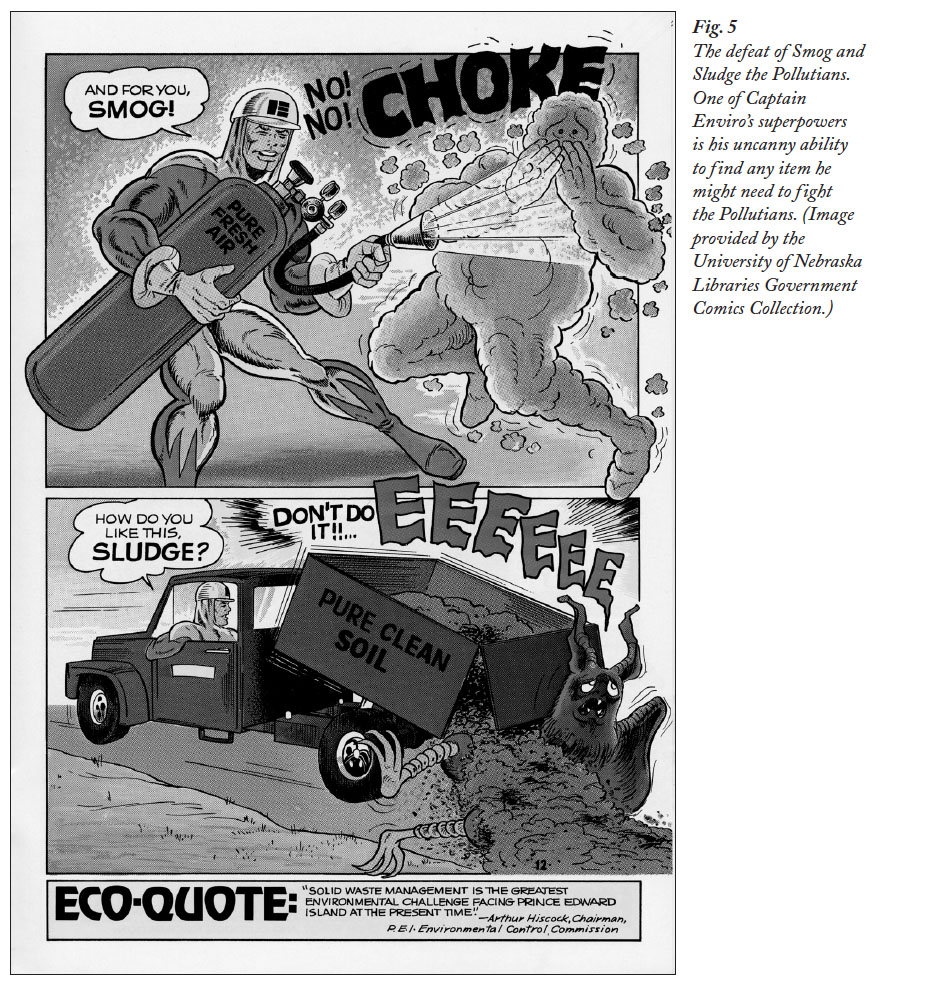 Display large image of Figure 5
Display large image of Figure 5Captain Enviro
12 Captain Enviro was the main eco-comic produced by Comic Book World for the Committee of Environment Ministers.9 While the comic book is only fourteen pages long, an analysis of its content does provide a deeper understanding of the more conservative form of environmentalism advocated by the Committee of Environment Ministers as part of its educational program in the early 1970s.10 The plot begins “millions of miles from Earth” on the planet Polluto, home of the Pollutians, where “the strange inhabitants thrive on every form of pollution.” It turns out the planet “has begun to show signs of cleanliness,” a death sentence for the Pollutians, so King Sewage III dispatches three “experts” from the Royal Pollutian Filth Force, Officers Sludge, Smog and Slime, to Earth, “the planet most likely soon to become polluted.” The aliens land their spaceship near Fredericton, and for the remainder of the eco-comic, Captain Enviro battles the Pollutians in various locations around the Maritimes, eventually defeating them and saving the day (Captain Enviro 1972: 1-3).
13 There are at least five main interrelated components to the environmental message of Captain Enviro. The first one is the fact that it was chosen to be delivered via comic book. As comics historians have noted, the comic book medium co-evolved with North American youth culture in the late 1930s and 1940s. The popularity of comic cooks waxed and waned throughout the mid-20th century, but creators like Stan Lee, Jack Kirby and Steve Ditko helped to revive interest in superhero comics by the late 1960s and early 1970s (B. W. Wright 2003; Lopes 2009). It is thus not surprising that the Committee of Environment Ministers decided to use this popular medium to try to reach individuals in junior high school, and familiar locales and settings were incorporated into Captain Enviro to make it more attractive to Maritime youth. Furthermore, the fairly high quality of the eco-comic added to its appeal. As John Bell has explained, Comic Book World “produced mostly full-colour comics that were distinguished by bold, engaging artwork and reasonably solid storylines” (1986: 25-26).
14 The second component is the gener- ally wholesome content of the comic book. The artwork in Captain Enviro is very similar to the cartooning style of many televisions shows from the late 1960s and early 1970s, including Scooby-Doo, Where Are You! (Hanna, Barbera and Nichols 1969-1978); Josie and the Pussycats (Hanna and Barbera 1970-1971); and Yogi’s Gang (Nichols 1973). There is also no graphic violence in Captain Enviro; instead, the creators relied on the common practice of using a series of words like “GLOP” and “SPLOT” to symbolize the more explicit aspects of action sequences (McCloud 1994 [1993]: 118-37). At the end of the eco-comic, when Captain Enviro defeats the Pollutians, their ultimate fate is ambiguously portrayed and the reader is left to fill in the blanks (Captain Enviro 1972: 11-14). Such elements were intended to make the comic book popular with parents, as the creators and government officials likely remembered the anti-comics fervour of the 1940s and 1950s. As part of this push for parental acceptance, Captain Enviro even contains a strong anti-drug message. At one point, the Pollutians drug Captain Enviro with a “magic mind pollutant,” and he embarks on a crazed polluting spree, very reminiscent of themes in the late 1930s film Reefer Madness (Gasnier 1938 [1936]; Captain Enviro 1972: 6-10).
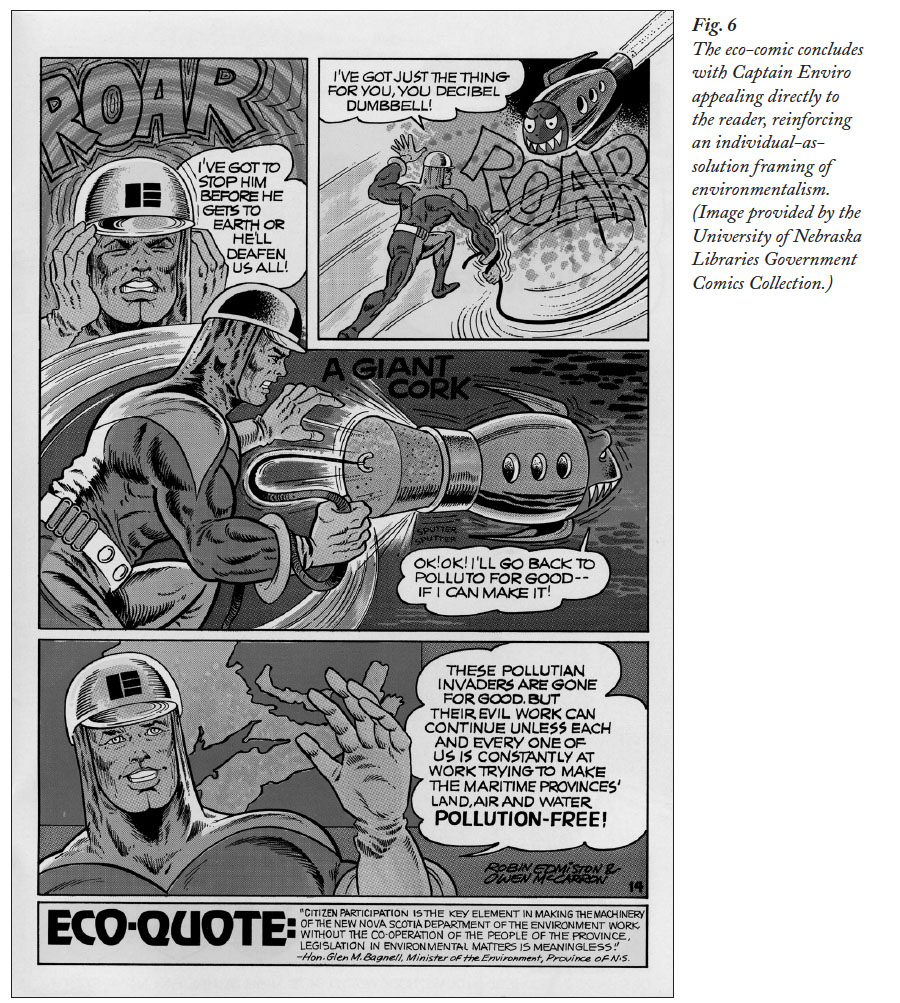 Display large image of Figure 6
Display large image of Figure 615 Another component is the character Captain Enviro, a superhero. This is significant because superhero-type characters can act as powerful vehicles of propaganda. As Christopher Murray has explained:
Captain Enviro, therefore, serves as a model of environmental behaviour for the reader, an ideal to live up to, a hero to emulate in day-to-day living. Of course, an obvious question is: how do we know Captain Enviro is actually a superhero? To answer such questions, Peter Coogan has developed the Mission–Powers–Identity conventions, a framework for determining whether a character is a superhero, whose mission is X, powers are Y, and identity is Z, and Captain Enviro obeys all three of the conventions. Captain Enviro’s “pro-social and selfless” mission is to fight to “save the Maritime environment.” His powers include great strength, the capacity to survive situations that “could kill an ordinary man,” a “pollutant-free eco-belt” that enables him to fly, and an uncanny ability to find any items he might need to fight the Pollutians. Finally, in terms of his identity, Captain Enviro is recognized by his costume, what is essentially a slick sanitation worker’s uniform, two shades of green that highlight his pro-environment stance, and an “E” chevron on his helmet (Coogan 2006: 30-60).
16 The fourth component of the environmental message of Captain Enviro is the supervillains, the Pollutians. Supervillains are the opposite of superheroes, the evil force that must be stopped by the good guys. If superheroes are models of behaviour, supervillains are examples of misbehaviour, or what not to do in day-to-day living. In academic parlance, supervillains serve as “The Other.” As Jason Dittmer and Soren Larsen point out in their article on depictions of aboriginality and the Arctic North, the process of othering has always been a feature of Canadian superhero comics (Dittmer and Larsen 2010). In Captain Enviro, by portraying the main source of pollution as alien beings, the eco-comic’s creators invoke a sense of otherness and externalize the problem of pollution. This is important for two reasons. It allows for the delivery of a pro-environment message without any discussion of the true sources of pollution, which fit perfectly with the more conservative form of environmental values advocated by the Committee of Environment Ministers. The externalization of the pollution problem also engages the reader without directly accusing him or her of being involved in polluting activities.
17 The final component is a focus on the individual as solution. This is effectively the larger message of the whole comic book, and in many ways all of the other components culminate with this last one. It is an emphasis on what the individual reader can do to help save the environment, rather than any sort of focus on structural problems within society. This lack of critique is the crux of the Committee of Environment Ministers’ wish to avoid “scare propaganda.” The comic book’s creators reinforced the focus on the individual through several means. First, the inclusion of “eco-definitions” on odd numbered pages supports an individual-as-solution framing of environmentalism by educating the reader about particular environmental terms, problems and solutions; for example, “Recycling: Reusing materials to save waste” appears on page nine. The provision of “eco-quotes” from the Maritime environment ministers on even numbered pages further supports this framing, while a “you can help save” list in the middle of the eco-comic suggests numerous pro-environment actions the reader can adopt as an individual. The comic book even concludes with Captain Enviro stating to the reader, “These Pollutian invaders are gone for good. But their evil work can continue unless each and every one of us is constantly at work trying to make the Maritime Provinces’ land, air and water POLLUTION-FREE!”
Conclusion
18 The rise of eco-comics in Canada was part of a broader appropriation of environmental education by the state in the 1960s and 1970s. Governments used eco-comics to advance their own environmental agenda, one intended to counter what they considered to be the radical views of some elements of the North American environmental movement. This agenda is perhaps best summed up by one of the eco-quotes in Captain Enviro. On page four, New Brunswick’s Minister of Fisheries and Environment Bill Cockburn is quoted: “There is no reason development cannot be compatible with proper environmental protection.” Captain Enviro was thus designed as an educational tool that emphasized a more conservative form of environmentalism, in particular the primacy of individual actions over society-wide solutions, which, in the view of government officials, did not inherently threaten post-war economic growth. Thousands of Maritime youth were exposed to Captain Enviro in the 1970s, potentially shaping their attitudes toward environmentalism for many years to come.
19 Yet, the effectiveness of the eco-comic was questionable. A 1974 review of the previous year’s educational program for the Committee of Environment Ministers claimed that “the posters, booklet, teacher’s notes and litter bags [garbage bags for cars] were considered most effective” (Meeting minutes of the Committee of Environment Ministers, May 6, 1974), but, by the late 1970s, state-sponsored environmental education was on the wane in North America, as neoliberal policies—small government, minimal taxation, pro-business—steadily gained influence. Indeed, with the elections of Ronald Reagan as President of the U.S. in 1980 and Brian Mulroney as Prime Minister of Canada in 1984, the neoliberal tide washed away many environmental education initiatives from government departments. However, the ebb did not last long. In the 1990s and 2000s, in conjunction with another wave of public concern, state-sponsored environmental education programs slowly re-emerged, albeit with similar types of environmental messages as those of a generation earlier (Carter and Simmons 2010); they continued to focus on the primacy of individual actions over society-wide solutions, including the promotion of recycling in public schools. Consequently, it remains highly doubtful that broad and meaningful change will occur so long as the state promotes an individual-as-solution framing of environmentalism and neglects to honestly address much-needed and deep-seated socio-economic reforms.
Earlier versions of this article were presented at the American Society for Environmental History Annual Meeting (Toronto, Ontario, April 3-6, 2013) and the 2nd Northeast and Atlantic Canada Environmental History Forum (Orono, Maine, September 28, 2013). Thank you to the participants for their comments. In addition, several people aided me in the development of this project. First off, thank you to Jim Finlay in Ontario, who mailed me a copy of Captain Enviro without remuneration. I also need to thank Joanna Aiton-Kerr at the Provincial Archives of New Brunswick for all of her help tracking down primary sources. Finally, a big thank you to Richard L. Graham at the University of Nebraska-Lincoln for agreeing to host Captain Enviro online.